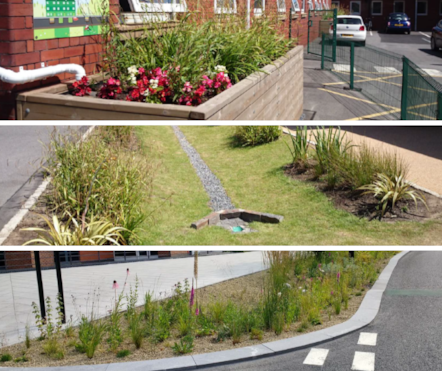FROM simple grass verges to flood-mitigating ‘rain gardens’ – an innovative way to see water from heavy downpours drain back into the sewers beneath our streets has been introduced in Grimsby.
Residents and visitors to Broadway will have noticed work being carried out to take out sections of grass at the roadsides, replacing them with flower beds.
What they perhaps do not realise is how these floral displays are not just there to brighten up the neigbourhood – they are also doing a vital job in helping to rid the street of water.
Underneath the beds, channels have been installed so the water flows from those beds, into storage tanks and then into the sewers – slowing down the flow into those sewers and therefore the risk of flooding is not eliminated, but certainly reduced.
North East Lincolnshire Council’s Portfolio Holder for Environment and Net Zero, Cllr Henry Hudson, praised the idea, saying: “It is these innovative and new schemes that in the long-term will make a big difference to the way in which we protect our communities from the changing environment, and how we cope with that.
He added: “This a great idea and two-fold in providing a floral backdrop along Broadway along with lessening the flood risk.”
This is the second such scheme carried out in North East Lincolnshire and manged by its partner Equans, and was funded by the Department for Environment, Food & Rural Affairs as part of its national £200m Flood and Coastal Innovation Programme.
North East Lincolnshire was awarded just over £3m from that total pot – with money ringfenced for flood and coastal resilience and adaption to a changing climate.
The first scheme, last year, saw planter boxes installed at four schools. The boxes, known as Roof Irrigation Planters, allow rainwater from the roof to flow directly into planter beds, increasing flood resilience by absorbing water and slowing the flow.
The Broadway works are due to be completed in August with three days of re-surfacing planned ahead of that, needing a road closure and diversions. The details of each road closure and dates are as follows:
Phase 1 – From the junction of Little Coates Road, up to and including the eastern junction of St Ives Crescent. Phase 1 will start on Monday 22 July.
Phase 2 – From the eastern junction of St Ives Crescent, up to and including the western junction of St Ives Crescent. Phase 2 will start on Tuesday 23 July.
Phase 3 – From the western junction of St Ives Crescent, through to the junction of Pershore Avenue. Phase 3 will start on Tuesday 27 August, following the construction of the remaining rain gardens along Broadway.
It is anticipated that each phase can be completed within one day. However, overrun into a second day is a possibility.
Article and image from NELC.

About the author